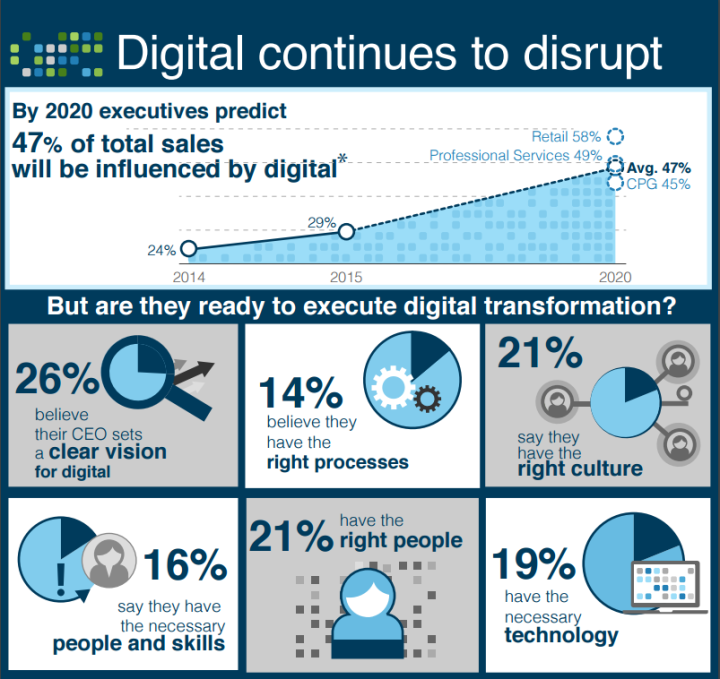Despite customer demand, competitive pressure, market trends, and sheer logic… many organizations are still not prepared nor able to successfully undergo their digital transformation.
Forrester in their “The State Of Digital Business 2015 To 2020” reported that only an average 20% of organizations have the right culture, processes, people, skills, and technology to successfully execute their digital transformation (figure below).
This begs the question “What can the other 80% of organizations do?”… let’s unpack and explore that.
Yes we can easily focus on these key gaps and try to address them independently. However, I believe these are simply symptoms of something more fundamental.
There are foundational things that organizations have to put in place to allow and embrace this type of transformation. Without these, your “change” leaders will be constantly hitting their heads against the corporate wall and your digital transformation will be extremely painful, slow, and costly.
Embrace a different way of being… not simply a different way of working
This is not simply about an internal culture change. This is a business decision with a internal cost and expected business results. The way you do business now, your processes, your technologies, etc… will not work. They were established on customer behaviours that don’t hold true anymore and they were not designed to evolve rapidly to meet the ever-changing customer and market shifts. I’m generalizing here but profit used to be driven by capital, scale, and efficiency. Welcome to rapidly changing global economy. Now your profit also (if not more so) depends on your ability to continously and quickly adapt to customer needs and market conditions. You have to redefine who you are, not simply how you do things.
Embrace a customer-centric understanding to business
This is not simply a buzz-word or popular digital strategy theme. This is a business investment that carries real financial risk. It’s a business decision that organizations must make. The customer is evolving and it is this very change that is fueling your necessity to evolve. It’s not an acknowledgment of submission. It’s an affirmation of how much you value the customer. The customer comes before the product. There is no product strategy or channel strategy before first having a customer strategy. You must start with the customer first. Yes that makes your strategy farm more complex, your financial projections less predictable (because attribution is not direct), and your sales strategy more holistic. The inconvenient truth is that your previous product and channel strategies / models never accurately reflected the complexity of customer and market behaviour. So stop being lazy and do it right. Put the customer, not yourself, in the center.
Embrace ambiguity and innovation as the necessary costs of evolution
Innovation is no longer something only some companies can afford. In the world of rapid evolution, you never have enough information to make business decisions with reliable success projects. Experimentation is the only way of discovering and overcoming business ambiguity and unknowns. You have to embrace this as a continuous competitive investment and survival necessity. More than that you have accept and manage the business risk associated with this ambiguity and innovation. You have to be financially prepare for failed experiments / investments while rewarding (not punishing) those that dare to innovate and push the envelope. More than creating or failing to create a new product, they are evolving your organization to be able to evolve quickly.
Only after your organization embraces these three truths (for some organizations there may be more), can your “change leaders” start planning and funding internal culture change efforts, staff retraining, realignment / restructures, new technologies and more.
Please comment on this post if you believe there are other fundamental changes that organizations have to embrace as preconditions for digital transformation.
Forrester report:
https://www.forrester.com/report/The+State+Of+Digital+Business+2015+To+2020/-/E-RES119838
https://www.forrester.com/staticassets/marketing/blogs/ForresterInfographicDigitalBusinessNigelFenwick18.pdf

